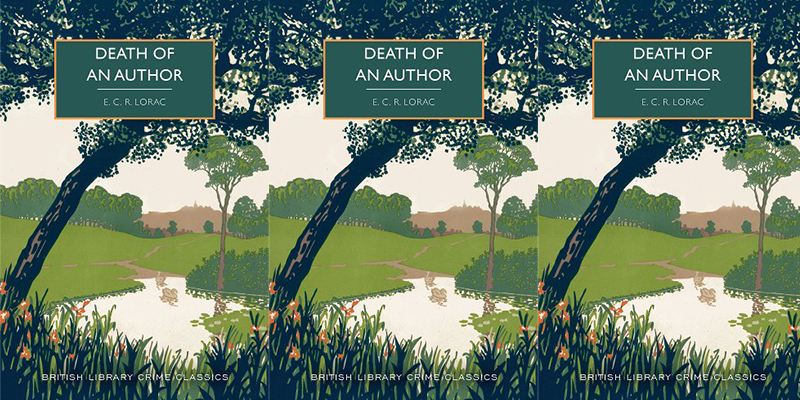Death of an Author is a rare example of a novel by E. C. R. Lorac (the principal pen name of Carol Rivett) that does not feature her popular and long-serving series detective Inspector Macdonald. The story is so entertaining, however, that we don’t miss him, especially given that Lorac introduces an appealing and capable pair of substitute investigators in Chief Inspector Warner of the CID and Inspector Bond.
The novel, originally published in 1935, boasts an unorthodox and well-crafted plot, but is particularly strong in its depiction of the literary world of the mid-1930s. This is a subject which evidently fascinated Lorac, and she returned to it more than once in subsequent novels, including These Names Make Clues, which has been republished as a British Library Crime Classic. Here, the opening scenes are especially pleasing and one can almost taste the relish with which she wrote them.
The story opens with an encounter between Andrew Marriott, a publisher, and his star author Michael Ashe, whose successes have made him a celebrity. They have a wonderful exchange in which Ashe threatens to write a crime novel, only for Marriott to respond: “Crime stories are a legitimate branch of fiction, but they’re mere ephemerals—selling like hot cakes today, and gone tomorrow.”
This view was widely held at the time, not least by many of those who wrote detective fiction. Among Lorac’s contemporaries, the poet Cecil Day-Lewis (whose mysteries were published under the name Nicholas Blake) and the broadcaster and priest Ronald Knox, undoubtedly regarded their whodunits as ephemeral, although Day-Lewis soon came to appreciate—and exploit—the literary potential of the genre. Even Agatha Christie gave spoilers about the solutions to four of her early mysteries in Cards on the Table, an Hercule Poirot novel of 1936, which suggests that she thought they had passed their sell-by date. Today, such modesty seems wholly misplaced.
Everything I’ve learned while researching Lorac over the years leads me to the conclusion that she had a stout belief in the value of her work, although no doubt she would have been not only thrilled but also amazed by the sales figures (and positive reviews) her books have achieved as a result of appearing in the Crime Classics series.
The conversation between Marriott and Ashe turns to a novel written by another of Marriott’s authors. The book in question is The Charterhouse Case by Vivian Lestrange. As Ashe says, Lestrange has “achieved the impossible—or at least, the improbable—by writing a crime story that is in the rank of first rate novels. His writing, his characterisation, and his situations all disarm criticism.”
Lestrange, it seems, is a recluse who refuses to have his photograph taken for publicity purposes and about whom nothing is known. Marriott and Ashe debate whether a book of such quality could really be the work of a newcomer and also the extent to which the authenticity of the prison life background of the story is such that it must be based on real life experience rather than simply meticulous research. Marriott concedes that: “to do them justice, some of the ‘thriller merchants’ take an infinite amount of trouble to get their facts vetted. The standard is going up steadily…”
Ashe persuades his publisher to arrange a dinner party at which he can meet the mysterious Lestrange. But a shock is in store. We are told that Lestrange is actually a young woman. Marriott regards her as “the coolest creature I ever met in my life!”
What follows is interesting and relevant to the storyline, and it also gives us an intriguing insight into Lorac’s attitude towards the treatment of female writers by reviewers and the publishing industry generally. On first meeting the young woman, Marriott said, “I have been flattering myself for years that I could tell a man’s writing from a woman’s…” Her response is blunt: “I get so sick of that theory. The minute a reviewer learns from some gossip that so and so is a woman, he promptly writes ‘there is a touch of femininity about the writings of X.Y.Z. Her descriptions are above criticism, but her dialogue betrays her sex.’ It’s all my eye and Betty Martin!” When Ashe—accompanied by Marriott and his colleague Bailley—meets the young woman, he is thunderstruck. She is scathing: “What but male conceit formulated that judgment of yours that no woman could have written a book which you admired? Is your estimate of all women the same?” She also makes a forceful case for equal treatment: “You envisage women still as the sheltered, emotional playthings of men. The woman of today is beginning to see through the fraud… We are still handicapped by the habit of thought of centuries, still too prone to acknowledge the unique splendour of the gifted male—but your ‘weaker vessel’ theory—I deride it!” Three months after that dinner party, however, a woman walks into Hampstead Police Station to announce that she is afraid that something has happened to Vivian Lestrange. The author is missing from home and so is the housekeeper. The elaborate mystery which gradually unfolds tests the detective skills of Warner and Bond, but they rise to the challenge. To say much more without giving too many spoilers is almost impossible, but although this has until now been a vanishingly rare book, most people lucky enough to read it in modern times have been greatly impressed.
Warner (who hates the idea of hanging and favours abolition: hardly a conventional view for policemen of his era) and Bond are a likeable duo. One minor mystery is why Lorac abandoned them after this novel. Perhaps the explanation lies in the fact that this was the last novel of hers published by Sampson Low. She moved to the more prestigious Collins Crime Club imprint, and it may well be that, since Macdonald was already a well-established series character, the publishers were keen for the author to make the most of him.
Edith Caroline Rivett (1894–1958), generally known as Carol Rivett, published her first detective novel in 1931. There can be little doubt—as the discussion in this book makes clear—that she adopted the ambiguous writing name of E. C. R. Lorac because of a suspicion of prejudice against female authors. She was so successful in hiding her identity that, many years later, the crime novelist and critic Harry Keating wrote of his astonishment at discovering, eventually, that she was a woman.
She wasn’t alone in fearing prejudice. In The Life of Crime: Detecting the History of Mysteries and Their Creators, I’ve discussed other female authors who masqueraded as men, notably Elizabeth Mackintosh (who was better known as Josephine Tey but whose first detective novel appeared under the name Gordon Daviot) and Lucy Malleson (who wrote most of her mysteries under the name Anthony Gilbert). Even Agatha Christie toyed, briefly, with the idea of adopting a masculine pseudonym. By 1936, however, Carol Rivett was confident enough to create a new literary identity using her own first name, and so was born Carol Carnac. One of the Carnac titles, Crossed Skis, has been reprinted as a British Library Crime Classic.
How it must have amused her to put these words in Warner’s mouth: “If I petitioned Parliament, do you think I could get an enactment that no man writes under any name but his own, and his finger-prints be registered on the title page?” When Bond points out that some writers produce different kinds of work under a host of different names, Warner groans: “Hardened offenders…recidivists, I call ’em.”
Late in life Carol Rivett used a further pen name, Mary Le Bourne, when writing Two-Way Murder. That book, however, did not find its way into print for more than sixty years prior to first publication in the Crime Classics series under the E. C. R. Lorac pen name. That is yet another good example of the strange and unpredictable nature of the author’s life, a subject right at the heart of this lively novel.
_______________


















